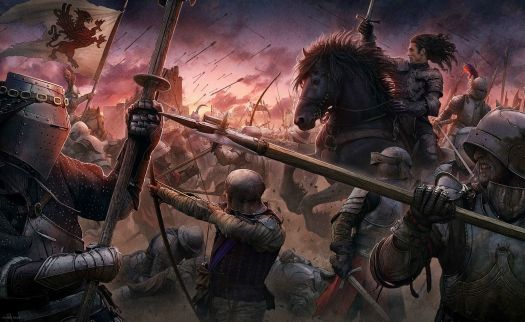Difference between revisions of "Combat Round"
Tao alexis (talk | contribs) |
Tao alexis (talk | contribs) |
||
| Line 1: | Line 1: | ||
[[File:Combat Round.jpg|right|525px|thumb]] | [[File:Combat Round.jpg|right|525px|thumb]] | ||
| − | '''Combat Rounds''' are units of time equal to 12 seconds. | + | '''Combat Rounds''' are units of time, nominally equal to 12 seconds. Because [[Combat|combat]] functions on a "turn-based system," these 12 seconds account for the movement of all sides in a conflict. Additionally, how much a given creature can do in the space of 12 seconds differs according to their speed — that is, the number of [[Action Points|'''action points''']] (AP) they possess. A creature with 5 AP can do more in 12 seconds than a creature with 3 AP. Multiple combatants may therefore be moving at different speeds, attacking at different moments with relation to each other ... this is why the "round" is recognized as a unit of time in name only. |
| − | + | When discussing the overall time that a combat has taken, the number of rounds are added together and multiplied by 12 seconds. But no part of the actual combat relies upon the passage of time as a unit. All actions rely upon the number of AP each combatant possesses. Additionally, the '''turn-based resolution''' of each combat round must be understood as '''metaphorical'''. All combatants in an ongoing combat are in constant motion, constantly swinging, dodging, parrying, occasionally striking their opponents. The enemy does not "wait" for the character party to make their attacks. The attacks are symbolic of the gestalt of all the fighting that has taken place up until the moment of the last thrown die. | |
| − | |||
| + | See also,<br> | ||
| + | [[Movement in Combat]]<br> | ||
| + | [[Movement (stride)]] | ||
| − | + | [[Category: Don't Review until 2022]] | |
| − | |||
| − | [[Category: | ||
Revision as of 03:04, 2 October 2021
Combat Rounds are units of time, nominally equal to 12 seconds. Because combat functions on a "turn-based system," these 12 seconds account for the movement of all sides in a conflict. Additionally, how much a given creature can do in the space of 12 seconds differs according to their speed — that is, the number of action points (AP) they possess. A creature with 5 AP can do more in 12 seconds than a creature with 3 AP. Multiple combatants may therefore be moving at different speeds, attacking at different moments with relation to each other ... this is why the "round" is recognized as a unit of time in name only.
When discussing the overall time that a combat has taken, the number of rounds are added together and multiplied by 12 seconds. But no part of the actual combat relies upon the passage of time as a unit. All actions rely upon the number of AP each combatant possesses. Additionally, the turn-based resolution of each combat round must be understood as metaphorical. All combatants in an ongoing combat are in constant motion, constantly swinging, dodging, parrying, occasionally striking their opponents. The enemy does not "wait" for the character party to make their attacks. The attacks are symbolic of the gestalt of all the fighting that has taken place up until the moment of the last thrown die.
See also,
Movement in Combat
Movement (stride)
